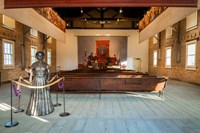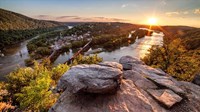- Lesson Plan (95)
- Distance Learning (20)
- Field Trips (18)
- Student Activities (8)
- Guest Speakers (1)
- Other Education Materials (1)
- Primary Sources (1)
- Teacher Reference Materials (1)
- Traveling Trunk (1)
- Bent's Old Fort National Historic Site (10)
- National Park of American Samoa (10)
- Glacier National Park (7)
- Channel Islands National Park (6)
- Everglades National Park (6)
- Shenandoah National Park (6)
- George Washington Carver National Monument (5)
- Glacier Bay National Park & Preserve (4)
- Hawaiʻi Volcanoes National Park (4)
- Show More ...
- Science (97)
- Social Studies (70)
- Literacy and Language Arts (27)
- Math (9)
Showing 144 results for HUMAN TRAFFICING ...
Human History Traveling Trunk
Women’s Rights are Human Rights
- Type: Lesson Plan
- Grade Levels: Upper Elementary: Third Grade through Fifth Grade

In this series of four lesson plans from the Erie Canalway National Heritage Corridor, students will be able to explore the development and growth of the American women's rights movement. This includes lessons about the Seneca Falls Convention, the Erie Canal, and the later women's rights movement. Developed by educator Lynn Girven of the Rochester City School District.
Horses and Humans: Shackleford Horses Unit
The Human Impact on the Living Planet Virtual Field Trip
- Type: Distance Learning
- Grade Levels: Middle School: Sixth Grade through Eighth Grade

Tracing the water cycle, from precipitation to surface water runoff, students investigate how humans’ impact the health of the environment. Through stories of everyday activities, students make predictions, conduct observations, and formulate conclusions as our staff conduct live experiments. After observing the test of a simple water filter, students propose changes to improve the design and discuss ways in which their community can reduce its impact on Earth’s resources.
"Where Do Human Rights Begin? In Small Places Close to Home."
- Type: Student Activities
- Grade Levels: High School: Ninth Grade through Twelfth Grade

This packet includes 4 different activities to help students understand the legacy of Eleanor Roosevelt and her work on social justice issues. Students will learn about the Universal Declaration of Human Rights and its impact on the lives of all people as well as Eleanor Roosevelt's impact on the country through her "My Day" columns.
Lesson 6 - RESEARCHING CONTEMPORARY SLAVERY
- Type: Lesson Plan
- Grade Levels: High School: Ninth Grade through Twelfth Grade
Why People Move: Human Migration (Grades 3-5) Lesson 1 of 3 Carl Sandburg Home NHS
- Type: Lesson Plan
- Grade Levels: Upper Elementary: Third Grade through Fifth Grade

Using examples from North Carolina's own migration history this lesson helps upper elementary students to understand the different types of human migration. Examples range from antebellum mountain summer homes to post-Civil War African American history. Western North Carolina has a long history of human migration in many forms. This lesson is a fun introduction to migration vocabulary with interactive activities to encourage critical thinking and the use of context clues by students.
First Lady of the World: Eleanor Roosevelt at Val-Kill
Models of Succession
- Type: Lesson Plan
- Grade Levels: Upper Elementary: Third Grade through Fifth Grade
Out of the Depths and into the Park: Geology of the Mississippi River Valley
- Type: Distance Learning ... Field Trips
- Grade Levels: Middle School: Sixth Grade through Eighth Grade
Traveling the National Road: Unit 5 Workers Along the National Road
- Type: Lesson Plan
- Grade Levels: Upper Elementary: Third Grade through Fifth Grade
Freeing the Elwha (Should the Dams on the Elwha be Removed? A Classroom Debate)
- Type: Student Activities
- Grade Levels: Middle School: Sixth Grade through Eighth Grade
Dams have been useful to human populations in providing water and energy for development of wilderness areas. Should we remove dams that have outlived their use in order to enhance the sustainability of natural and human communities?
National Park Legacy - Coyotes in our Cities! Grades 3 - 4
- Type: Lesson Plan
- Grade Levels: Upper Elementary: Third Grade through Fifth Grade

The Nature Neighbor Project prioritizes reducing conflicts between humans and wildlife so that they can coexist and share available habitat. Ecologists have learned that coyotes are opportunistic eaters, and they will scavenge through trash as well as feed on traditional foods such as rodents, birds, insects, and grass. Coyote and human conflicts can often be eliminated when human-related food is not available.
Water Power: Field Trip
- Type: Field Trips
- Grade Levels: High School: Ninth Grade through Twelfth Grade
Boundaries and People
Making Tracks
- Type: Field Trips
- Grade Levels: Middle School: Sixth Grade through Eighth Grade

On this field trip to either C&O Canal National Historical Park or the George Washington Memorial Parkway, students will conduct a field study activity, to identify some of the ways human impacts affect organisms that live in the Potomac and assess the human impact on a 20-meter stretch of trail in the park.













